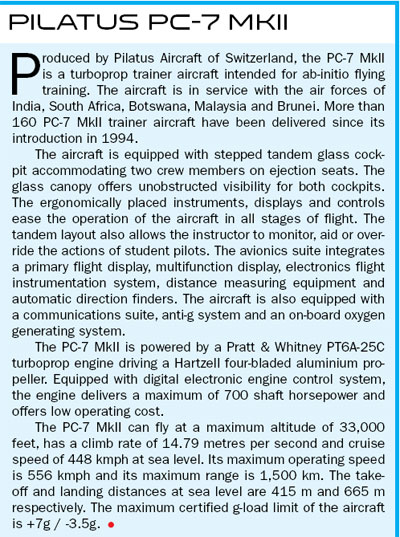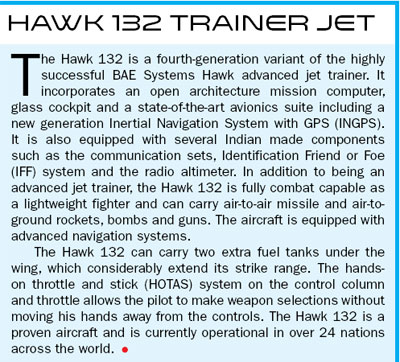INDIAN ARMED FORCES CHIEFS ON
OUR RELENTLESS AND FOCUSED PUBLISHING EFFORTS

SP Guide Publications puts forth a well compiled articulation of issues, pursuits and accomplishments of the Indian Army, over the years

I am confident that SP Guide Publications would continue to inform, inspire and influence.

My compliments to SP Guide Publications for informative and credible reportage on contemporary aerospace issues over the past six decades.
Training: The Making of an IAF Combat Pilot
With the induction of this lead-in trainer beginning in 2008, the long-standing gap between the performance of the basic jet trainer and frontline combat aircraft has been effectively bridged

In its post-independence history, the Indian Air Force (IAF) by and large, has had a fairly stable fleet of basic trainer aircraft most of it produced by the Indian aerospace major Hindustan Aeronautics Limited (HAL). However, there have been two areas in which the IAF has had to resort to procurement of trainer aircraft from abroad. The first was the Hawk 132 advanced jet trainer (AJT) from British Aerospace during the last decade and more recently, the Pilatus PC-7 MkII from Pilatus Aircraft of Switzerland.
The Advanced Jet Trainer
For several decades of its existence, the training curriculum for fighter pilots in IAF was devoid of a platform that could serve as the critical transitional link between jet trainers and high performance combat aircraft. The need to close this gap through the induction of an AJT was articulated by the IAF for the first time in 1982. This was assessed as an urgent and an inescapable requirement as in the preceding decade-and-a-half the IAF had suffered number of accidents that were attributable to human error. A majority of these accidents involved fighter pilots who had graduated to the MiG-21 supersonic aircraft directly after training on basic jet trainers. In the search for a solution, the IAF soon after identified the Hawk, an aircraft with established credentials, to be the right platform to serve as the AJT. However, the elaborate procurement process took over two decades to reach the stage of award of contract.
Initially, the IAF had pegged the requirement at 122 aircraft. However, on account of the protracted negotiations and the consequent delay leading to cost escalation, the order was revised downwards to 66 aircraft with option for another 40. The contract for the supply of 66 Hawk 132 AJT aircraft, the latest in the series, that was finally signed between the Ministry of Defence and BAE Systems on March 26, 2004, envisaged 24 units built in the United Kingdom and the remaining 42 produced under licence by HAL at Bengaluru. As of today, including the repeat order for 40 aircraft for Stage III training and 20 additional aircraft for the new formation aerobatic team, the Hawk inventory of the IAF will reach 126. With the 17 naval version of the Hawk ordered by the Indian Navy, the total number would go up to 143.
The Hawk formally entered service with the IAF on February 23, 2008 and within three years, the AJT fleet was built up to full strength. In the meantime, in 2010, the IAF declared its intention to order another 40 aircraft that would be manufactured under licence by HAL. On February 10, 2011, HAL signed a contract with GE Aviation to provide maintenance on the Hawk fleet for the next 30 years. Thereafter in December 2011, BAE received a contract to provide the IAF with spares and ground support for the Hawk fleet.

Qualitative Change
Although the induction of the Hawk into the IAF was a long and arduous process spread over more than two decades, it has fulfilled a long pending requirement of the service and flags a major milestone in the domain of flying training of fighter pilots. With the induction of this lead-in trainer beginning in 2008, the long-standing gap between the performance of the basic jet trainer and frontline combat aircraft has been effectively bridged. Budding fighter pilots are now able to transit with relative ease from basic jet trainers such as the HJT-16, Kiran, on to high performance aircraft such as the MiG-29, Mirage 2000, the Su-30MKI and subsequently hopefully even on to the medium multi-role combat aircraft (MMRCA) as and when these are inducted into the IAF. The Hawk fleet has undoubtedly served to bring about a qualitative change in the training of combat pilots of the IAF and has definitely enhanced flight safety.
Search for a Basic Trainer Aircraft
With the rather sudden and premature grounding of the piston-engine HPT-32 fleet in July 2009, the IAF had a serious crisis on its hands as it was quite left with no aircraft for Stage I training. Designed, developed and built by HAL, the HPT-32 aircraft reportedly had an inherent design flaw on account of which there were a number of episodes of engine shut down in flight leading to loss of aircraft and lives. Circumstances compelled the IAF to carry out Stage I training on the HAL-built HJT-16 Kiran jet trainer that was being used for Stage II training. This arrangement was neither desirable nor sustainable.
As HAL was not in a position to provide a replacement for the HPT-32 in a respectable time frame, the IAF had no option but to explore foreign sources for a suitable platform and soon enough to resume Stage I training on a propeller driven aircraft. A global tender for a basic trainer aircraft floated on December 16, 2009, saw a number of contenders entering the fray namely Pilatus PC-7 MkII from Pilatus Aircraft of Switzerland, KT-1 from Korean Aerospace, the Texan T-6C from the then Hawker Beechcraft, the EMB-314 Super Tucano from Embraer, Alenia Aermacchi M-311 jet trainer from Finmeccanica, PZL-130 Orlik TC II from EADS and the G-120 TP from Grob Aircraft of Germany.
In May 2012, the IAF declared the Pilatus PC-7 MkII as the preferred platform. A contract was signed with Pilatus Aircraft of Switzerland for the supply of 75 aircraft in fly-away condition along with integrated ground based training system and a logistics support package. There was also the option for another 30 aircraft within three years of signing the contract.
Induction of the Pilatus PC-7 MkII commenced in February 2013 and deliveries are expected to be completed by 2015. Given the impeccable credentials of the original equipment manufacturer (OEM) Pilatus Aircraft of Switzerland, there ought to be no doubt about the time frame for completion of delivery of the 75 aircraft ordered.

Performance Par Excellence
Based at the Air Force Academy near Hyderabad, the premier flying training establishment of the IAF, the strength of the Pilatus fleet currently stands at 40. Since the commencement of induction in February 2003, the Pilatus fleet has recorded commendable performance logging around 15,000 hours of accident-free flying. The experience of the IAF indicates that the fleet demands low maintenance, offers high reliability and exceptional serviceability rates, all resulting in high flight line availability. The OEM Pilatus Aircraft of Switzerland has also been proactive in providing excellent product support. The credible performance of the fleet so far has inspired the IAF to embark on enhancement of intake of trainee pilots by 150 per cent as well as to increase the number hours in the basic flying training syllabus by 220 per cent. Solo flying by trainee pilots is also being increased from one to 14 sorties. This not only reflects a qualitative change in basic flying training in the IAF; but also the high level of confidence that the Pilatus PC-7 MkII fleet has generated in the IAF. As per Air Chief Marshal Arup Raha who flew a sortie on the aircraft during his visit to the Academy, the induction of Pilatus PC-7 MkII as a basic flying trainer has met the long aspired need of the IAF.
In March this year, the first PC-7 MkII fixed base full mission simulator became operational at AFA. The second simulator and additional ground-based training systems are to be installed by the end of this year. Also, reflecting clear preference for the Pilatus PC-7 MkII over the proposed HTT-40 to be designed, developed and built by HAL in a time frame that continues to remain highly uncertain, the IAF has placed orders for another 37 of these aircraft under follow-on contract that will take the fleet strength with the IAF to 112 against a total requirement of 180 machines. The IAF is once again compelled to resort to direct purchase from the OEM as HAL, on account of their own compulsions, are not inclined to build the Pilatus PC-7 MkII under licence which would have been far more expedient.





